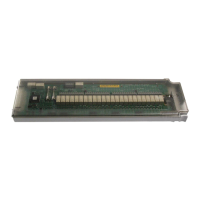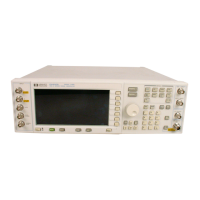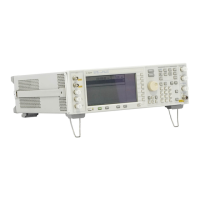1-89
Troubleshooting
Overall Description
Output Power Level/Automatic Leveling Control
The output power control circuitry, commonly referred to as the ALC loop, comprises the following:
• Two detectors: the A23 Lowband Coupler/Detector (frequencies ≤2 GHz) and the A24 Highband
Coupler/A25 Highband Detector (frequencies >2 GHz). Note: this is not the same frequency
breakpoint as defined by the lowband and highband paths.
The couplers couple off a small portion of the RF signal and route it to the detectors. The
detectors convert the RF signal to a dc voltage proportional to the RF power level, and that dc
voltage is routed to the A10 ALC.
• An ALC assembly (A10)
• Two ALC modulators
In ALC leveling on (closed loop operation), the output level is detected and a voltage fed back and
compared to a reference voltage. The output of the comparator controls the modulator drive current,
which controls the output power level. When the detected and reference voltage levels are the same,
the modulator drive current remains constant. When the detected and reference levels are not the
same, the modulator drive current changes, causing the RF output power to increase or decrease
until the reference and detected voltages are the same.
In ALC leveling off (open loop operation), only a reference voltage is used to control the modulation
drive current. The comparator output is the sum of the reference voltage and stored calibration data
for that frequency point; no feedback is provided. The stored calibration data is correction
information stored in the instrument during power level calibration; it adjusts for any losses that
occur after the coupler/detector. The reference voltage is generated on the A10 ALC by a DAC, the
output voltage of which is the result of the power level set on the front panel.
Leveling during ramp sweep (Option 007) In ramp sweep mode, a sweep compensation
reference voltage is routed from the A9 YIG Driver assembly to the A10 ALC to improve leveling
during sweep operation. The A18 CPU controls the ALC reference correction DAC on the A9 YIG
Driver.
Analog Modulation
The RF can be modulated using either external signals or internal signals from the
A11 Pulse/Analog Generator. The A11 Pulse/Analog Generator includes a pulse generator and a
numeric synthesizer to provide AM, FM, PM, and pulse modulation capabilities. For better phase
modulation control, the internal generator is tied to the A7 Reference 10 MHz.
Internally generated signals up to 1 MHz can be switched to the LF Output BNC on the front panel.
A11 Pulse/Analog output signals are routed as follows:
Improved Pulse Performance <3.2 GHz (Option 1E6) Option 1E6 installs a pulse modulator
between the A8 Output board and A23 Lowband Detector to improve pulse performance below
3.2 GHz. The pulse drive signal is switched from the A8 Output board to the 1E6 assembly.
Modulation Type Routed to
Amplitude A10 ALC
Pulse A30 Modulation Filter and A8 Output
Frequency and Phase A6 Frac–N

